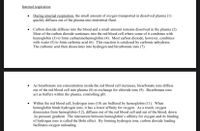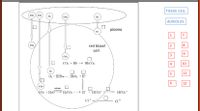
Human Anatomy & Physiology (11th Edition)
11th Edition
ISBN: 9780134580999
Author: Elaine N. Marieb, Katja N. Hoehn
Publisher: PEARSON
expand_more
expand_more
format_list_bulleted
Question

Transcribed Image Text:Internal respiration
During internal respiration, the small amount of oxygen transported in dissolved plasma (1)
quickly diffuses out of the plasma into interstitial fluid.
Carbon dioxide diffuses into the blood and a small amount remains dissolved in the plasma (2).
Most of the carbon dioxide continues into the red blood cell where some of it combines with
hemoglobin (3) to form carbaminohemoglobin (4). Most carbon dioxide, however, combines
with water (5) to form carbonic acid (6). This reaction is catalyzed by carbonic anhydrase.
The carbonic acid then dissociates into hydrogen and bicarbonate ions (7).
As bicarbonate ion concentration inside the red blood cell increases, bicarbonate ions diffuse
out of the red blood cell into plasma (8) in exchange for chloride ions (9). Bicarbonate ions
act as buffers within the plasma, controlling pH.
Within the red blood cell, hydrogen ions (10) are buffered by hemoglobin (11). When
hemoglobin binds hydrogen ions, it has a lower affinity for oxygen. As a result, oxygen
dissociates from hemoglobin (12), diffuses out of the red blood cell and out of the blood, down
its pressure gradient. The interaction between hemoglobin's affinity for oxygen and its binding
of hydrogen ions is called the Bohr effect. By forming hydrogen ions, carbon dioxide loading
facilitates oxygen unloading.

Transcribed Image Text:TISSUE CELL
CO:
CO:
O2
CO:
ALVEOLUS
plasma
| 1
7
red blood
2
8
cell
9
3
CO:
Co2 + Hb + HBCO2
4
10
5
11
O, + HHb.
HbO, + H*
12
CO:
carbonic
anhydrne
Co. + H:O"
H:COs
• H* + HCO,
HCO;
C1-
Expert Solution
This question has been solved!
Explore an expertly crafted, step-by-step solution for a thorough understanding of key concepts.
Step by stepSolved in 2 steps with 1 images

Knowledge Booster
Similar questions
- How is the bulk of carbon dioxide transported in blood? O chemically combined with the heme portion of hemoglobin as carbonic acid in the plasma O chemically combined with the globin portion of hemoglobin O all of the abovearrow_forwardE 100 Og unloaded from, hemeglobin during normal 80 metabolism Og reserve that can be unloaded from hemoglobin to tissues with high metabolism 20 40 60 80 100 Tissues during Tissues exercise Luings at rest mm Hg) (a) Po, and Hemoglobin Dissociation at 37C and pH 74 What is the % 02 saturation in the lungs? [ Choose [ Choose 104 What is the PO2 in the lungs? 40 98 70 What is the % 02 saturation in tissues at [ Choose ) rest? What is the PO2 in tissues at rest? [ Choose ) o, saturation of hemoglobin () >arrow_forwardIn control of ventilation, which of the following is the most important? PCO2 in the blood PO2 in the blood PCO2 in the inspired air O PO2 in the inspired airarrow_forward
- Scenario: In Charles’ blood, the partial pressure of CO in the blood (0.4 mm Hg) is far lower than the partial pressure of O2, yet the percent saturation of hemoglobin by each gas is approximately equal. What does this tell you about the affinity of hemoglobin for CO?arrow_forwardAll of the following factors increase hemoglobin's affinity for oxygen EXCEPT: Increased temperature Increased pH Decreased pCO2 Decreased 2,3-DPG All of the above increase hemoglobin's affinity for oxygen The conduction zone: Question 7 options: participates in some gas exchange secretes mucus which is moved down into the respiratory zone of the lungs dries moist air as it moves into the respiratory zone equilibrates incoming air to body temperature none of the above are correct The respiratory membrane for gas exchange includes (select the best answer): Question 8 options: Capillary endothelial cells Type I alveolar cells Type II alveolar cells A and B above A and C abovearrow_forwardtrue or false ? Oxygen binding to hemoglobin has what affect on additional molecule of oxygen binding to the same molecule of hemoglobin?arrow_forward
- Describe the entire pathway that oxygen travels from the pulmonary capillaries in the lungs to the heart and to the final destination in the liver hepatocyte (include all structures)arrow_forwardRespiratory Concept Mapping Construct a map of gas transport using the following terms. You alveoli arterial blood carbaminohemoglobin carbonic anhydrase chloride shift dissolved CO₂ dissolved O₂ hemoglobin hemoglobin saturation oxyhemoglobin Po CO2 plasma 02 pressure gradient red blood cell venous bloodarrow_forwardKnow the structure and functions of hemoglobin and the three determinants for how much oxygen is boundarrow_forward
- Some Events Related to Breathing 1 increased rate of breathing 2 Nervous stimulation of the diaphragm 3 Increased concentration of CO 2 in the blood 4 Decreased concentration of CO 2 in the blood 5 Chemical stimulation of the respiratory centre The sequence of events that occurs as the breathing rate is increased Is a) 3,5,2,1 and 4 b) 5,3,1,2 and 4 c) 3,2,4,1 abd 5 d) 4,3,5,2 and 1arrow_forward1. Is this statement correct or incorrect? Explain. During strenuous exercise, the oxygen-hemoglobin dissociation curve shifts to the right. This rightward shift reflects an increase in the affinity of hemoglobin for oxygen and favors loading of O2 onto hemoglobin in the lungs. 2. Is this statement correct or incorrect? Explain. Compared to hemoglobin, myoglobin has a lower binding affinity for O2 and a higher O2 binding capacity, two characteristics that allow myoglobin to efficiently provide skeletal muscle cells with a readily-accessible reservoir of O2.arrow_forwardplease help with this practice problemarrow_forward
arrow_back_ios
SEE MORE QUESTIONS
arrow_forward_ios
Recommended textbooks for you
 Human Anatomy & Physiology (11th Edition)Anatomy and PhysiologyISBN:9780134580999Author:Elaine N. Marieb, Katja N. HoehnPublisher:PEARSON
Human Anatomy & Physiology (11th Edition)Anatomy and PhysiologyISBN:9780134580999Author:Elaine N. Marieb, Katja N. HoehnPublisher:PEARSON Anatomy & PhysiologyAnatomy and PhysiologyISBN:9781259398629Author:McKinley, Michael P., O'loughlin, Valerie Dean, Bidle, Theresa StouterPublisher:Mcgraw Hill Education,
Anatomy & PhysiologyAnatomy and PhysiologyISBN:9781259398629Author:McKinley, Michael P., O'loughlin, Valerie Dean, Bidle, Theresa StouterPublisher:Mcgraw Hill Education, Human AnatomyAnatomy and PhysiologyISBN:9780135168059Author:Marieb, Elaine Nicpon, Brady, Patricia, Mallatt, JonPublisher:Pearson Education, Inc.,
Human AnatomyAnatomy and PhysiologyISBN:9780135168059Author:Marieb, Elaine Nicpon, Brady, Patricia, Mallatt, JonPublisher:Pearson Education, Inc., Anatomy & Physiology: An Integrative ApproachAnatomy and PhysiologyISBN:9780078024283Author:Michael McKinley Dr., Valerie O'Loughlin, Theresa BidlePublisher:McGraw-Hill Education
Anatomy & Physiology: An Integrative ApproachAnatomy and PhysiologyISBN:9780078024283Author:Michael McKinley Dr., Valerie O'Loughlin, Theresa BidlePublisher:McGraw-Hill Education Human Anatomy & Physiology (Marieb, Human Anatomy...Anatomy and PhysiologyISBN:9780321927040Author:Elaine N. Marieb, Katja HoehnPublisher:PEARSON
Human Anatomy & Physiology (Marieb, Human Anatomy...Anatomy and PhysiologyISBN:9780321927040Author:Elaine N. Marieb, Katja HoehnPublisher:PEARSON

Human Anatomy & Physiology (11th Edition)
Anatomy and Physiology
ISBN:9780134580999
Author:Elaine N. Marieb, Katja N. Hoehn
Publisher:PEARSON

Anatomy & Physiology
Anatomy and Physiology
ISBN:9781259398629
Author:McKinley, Michael P., O'loughlin, Valerie Dean, Bidle, Theresa Stouter
Publisher:Mcgraw Hill Education,

Human Anatomy
Anatomy and Physiology
ISBN:9780135168059
Author:Marieb, Elaine Nicpon, Brady, Patricia, Mallatt, Jon
Publisher:Pearson Education, Inc.,

Anatomy & Physiology: An Integrative Approach
Anatomy and Physiology
ISBN:9780078024283
Author:Michael McKinley Dr., Valerie O'Loughlin, Theresa Bidle
Publisher:McGraw-Hill Education

Human Anatomy & Physiology (Marieb, Human Anatomy...
Anatomy and Physiology
ISBN:9780321927040
Author:Elaine N. Marieb, Katja Hoehn
Publisher:PEARSON